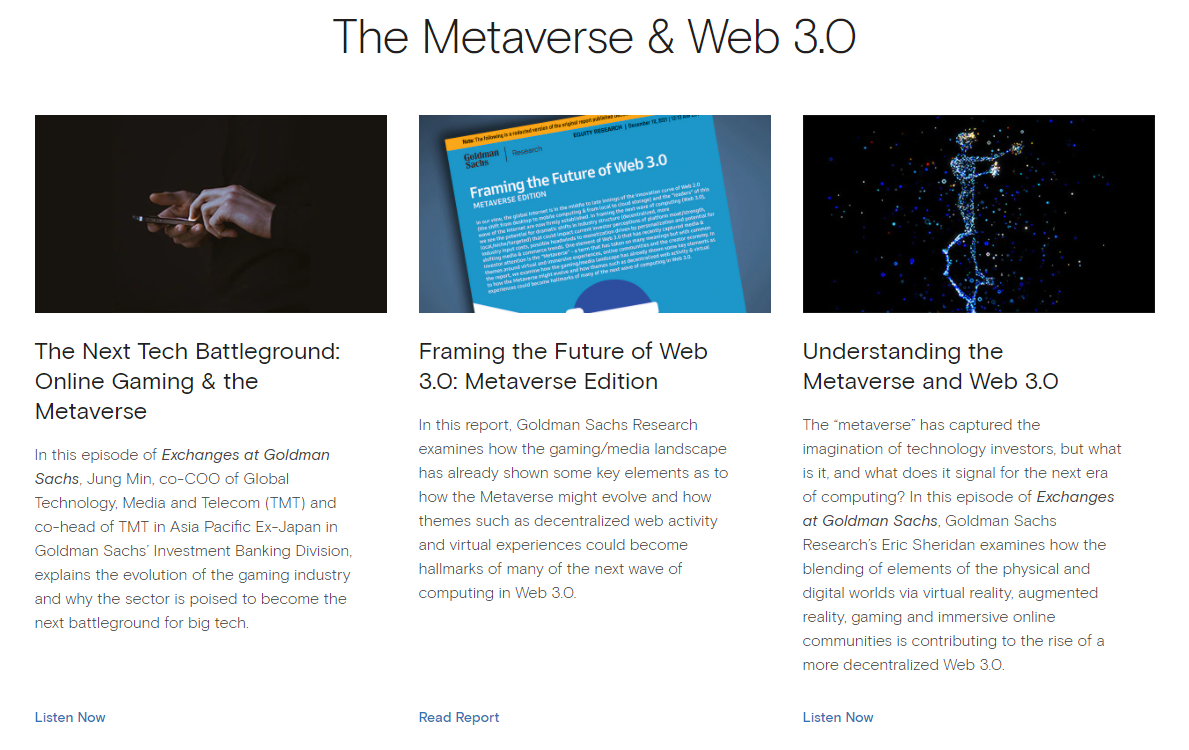Investment banking giant Goldman Sachs credits the metaverse with a large market that includes technology and platforms as well as brisk global trade, creating a new ecosystem in their view. Besides NFTs, cryptocurrencies are also part of their vision of the future.
Over the past six months, the metaverse has gained traction across industries. While the metaverse connects the physical and virtual worlds through innovations in hardware and software, it also requires an economic system to thrive. Here, according to Goldman Sachs, we will see NFTs and cryptocurrencies take center stage to unlock value. To emphasize its enthusiasm for the field, the second-largest U.S. investment bank promoted its reports on the topic to its front page. Cryptocurrencies, Web3 and Metaverse are, after all, the three most important "mega-trends of digitalization" that will transform our economies.
Great potential of the metaverse
To truly understand the possibilities of the metaverse for banking, Goldman Sachs first explains what constitutes the metaverse and what building blocks actually underlie this digital twin of our current reality. They identify four distinct pieces of the puzzle: technology, platform, marketplace, and commerce. Each of these building blocks would be driven by a unique group of ecosystem players who have gone through their own maturation curve.
Already, several companies have estimated the potential size of the metaverse. Brand Essence Research estimates the market will exceed 200 billion in 2021, with a potential of more than 600 billion in 2027. Investment bank Morgan Stanley predicted last November that the metaverse represents an $8 billion market opportunity. Ark Investment Management managing director Cathie Wood believes the metaverse will be a multi-billion dollar market, while crypto asset manager Grayscale Investments and JPMorgan estimate the potential business opportunity at just $1 billion.
Goldman Sachs Research
Goldman Sachs' analyst Eric Sheridan explained the bank's metaverse forecast in a recent "Exchanges at Goldman Sachs" episode titled "Understanding the metaverse and Web 3.0." The "metaverse" has captured the imagination of technology investors, but what is it and what does it mean for the next era of computing? In the January edition of the podcast, Sheridan explored how the merging of elements of the physical and digital worlds through virtual reality, augmented reality, gaming and immersive online communities is contributing to the emergence of a more decentralized Web 3.0.

In their report "Framing the Future of Web 3.0", Goldman Sachs Research also reveals how the gaming/media landscape has already shown some key elements for the development of the metaverse. In addition, topics such as decentralized web activities and virtual experiences are found, which could become hallmarks in the next wave of digitization. As a trifecta, the two podcasts and the in-depth research report were exhibited on the investment bank's home page, underscoring its commitment to this area.
The role of finance in the metaverse
Although it appears that the focus will be on virtual reality, digital assets, blockchain, cryptocurrencies and, most importantly, video games, the Metaverse will actually offer much broader opportunities across many industries, according to Goldman. The bank expects the Metaverse to become a major digital platform for both personal and business interactions, including finance.
Just like in the real world, anyone operating in the metaverse would be able to conduct financial transactions. Users would be able to purchase avatars, virtual accessories, or entire environments and properties created by companies or other individuals. In addition, users would want to conduct peer-to-peer transactions that do not fall within the traditional "consumer versus business" paradigm.
All these transactions will require a new kind of financial infrastructure. According to Goldman Sachs, most traditional banks are already thinking about how to tap into this space. There are financial players who are moving quickly into the metaworld to position themselves as pioneers of the future of digital finance. As the Korea Times noted in August 2021, brokerage houses and banks in Korea have already begun creating active virtual environments for their clients. Surprisingly, however, the investment bank felt that traditional financial institutions may not be major players in the emerging metaverse at all.
Major Swiss banks hold back
The crypto involvement of various US banks has increased sharply. In addition to Goldman Sachs, financial giants JPMorgan, Bridgewater, Morgan Stanley and many more have entered the space. They have all seen potential in the rapidly growing industry and are expanding their offerings to customers. This is despite the somewhat tenuous regulatory situation in the United States. In Switzerland, the so-called Crypto Valley, the framework conditions would actually be ideally set. Nevertheless, the local big banks remain cautious.
Swiss banking giant UBS says it has received repeated customer inquiries about digital assets in recent years. In January 2021, for example, they published an article titled "Should I Buy Bitcoin?". In it, UBS took a mostly skeptical stance and recommended that clients keep their hands off cryptocurrencies. Just a few months later, the major bank warned again about the risks of the "crypto bubble". Competitor Credit Suisse acknowledges Bitcoin as an emerging asset class, but they too are shying away from initial client offerings. The issues of money laundering and sustainability as well as regulation are not yet advanced enough, according to CEO Thomas Gottstein.




